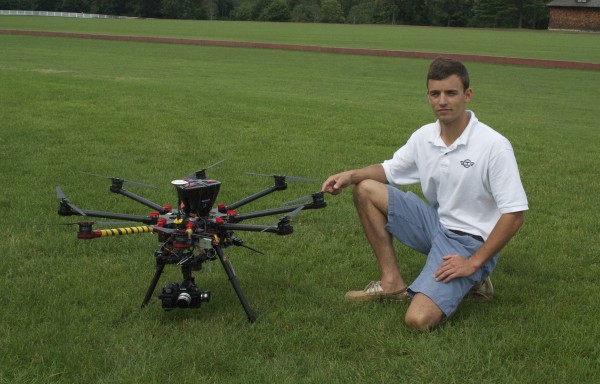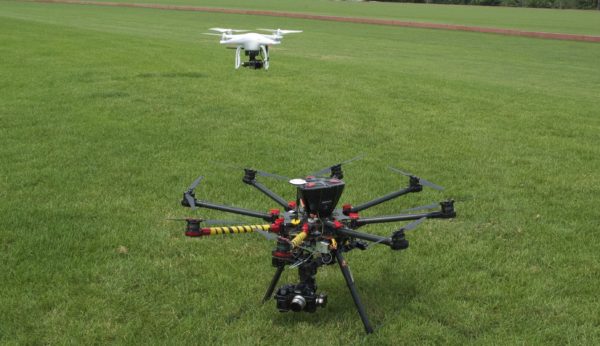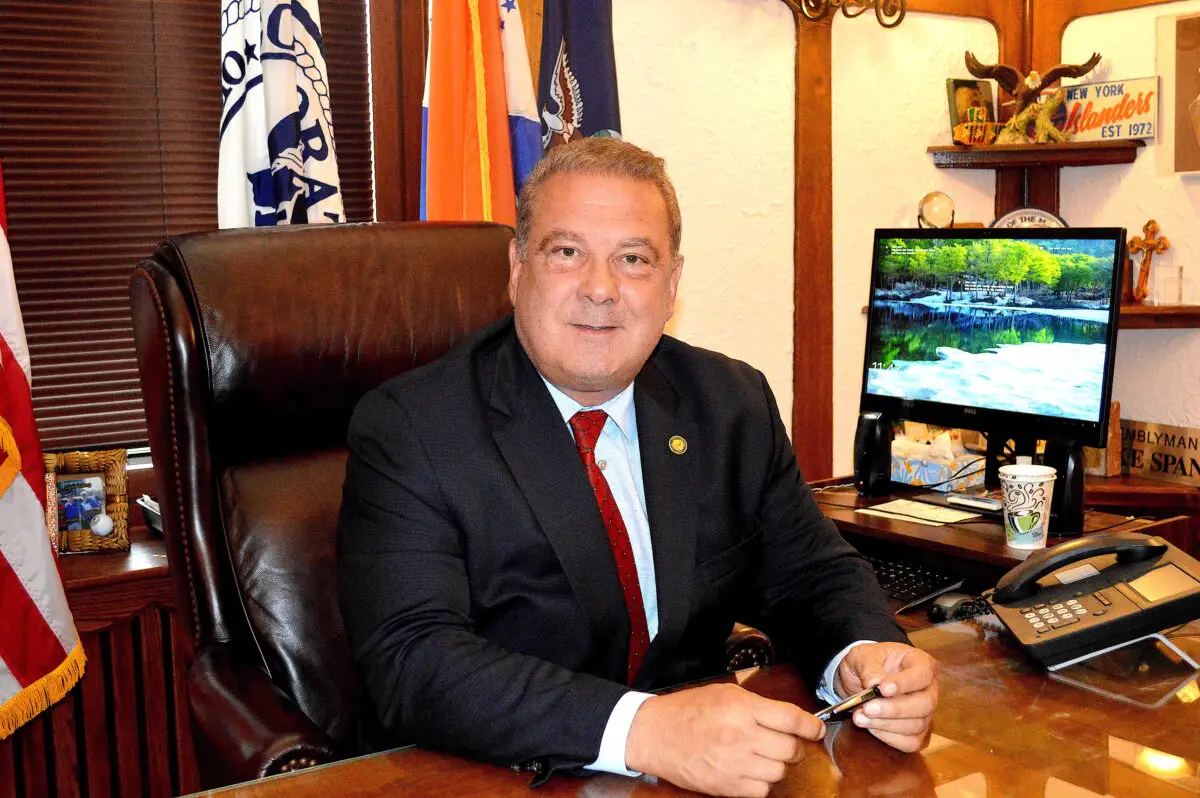William Granruth”™s aerial drone photography and cinematography business is taking off.
Granruth, president of Osprey Imaging in Greenwich, said sales have grown “exponentially” since founding the company about 18 months ago. Osprey”™s eight drones are equipped with high-quality cameras and fly over and capture footage of real estate as well as sporting events including golf, sailing and polo.
“You all of the sudden unlock this perspective I think hasn”™t ever been achieved before,” Granruth, 24, of Greenwich, said about the aerial shots he can take with a drone.

- William Granruth next to one of his company”™s drones at Greenwich Polo Club, which he uses to take aerial shots of real estate in Fairfield County. Photo by Danielle Brody
Drones are unmanned aerial vehicles operated by a human with a remote control. They can fly within feet of a subject to take close-up shots and follow quick movement. Granruth, an aviation enthusiast his entire life, said he has flown small planes and had been flying drones for a couple of years. He saw a market opportunity as the regulatory environment started to open and allow for his type of business.
The Federal Aviation Administration is still finalizing its long-delayed rules for commercial drone users operating unmanned aircraft systems of less than 55 pounds. In the meantime, it recently streamlined the process for so-called “Section 333 exemptions,” which authorize commercial activity. Individuals who are granted a Section 333 exemption receive a letter alerting them of the more than 30 rules already in place, such as drone maintenance and keeping the machines in direct line of sight.
Granruth said his company filed for the exemption and has $5 million liability insurance. Both precautions protect the company and clients that hire Osprey, he said.
Granruth said he invested about $30,000 to start the business he runs with his friends and partners, Alex Pugliese, who handles creative, and Phil Brown, who does marketing. The company uses two large, eight-blade DJI S1000 drones that can fly up to 60 miles per hour and six small, four-blade DGI Phantom drones that can fly up to 30 miles per hour. Granruth configured the drones with equipment and values them at about $15,000 and $2,000, respectively.
While drones are relatively easy to fly and not too expensive to purchase, Granruth said the barrier to entry is the time it takes to learn how to take the best aerial shots, which are completely different than on-the-ground shots and depend on many factors. He said he has spent hundreds of hours practicing flying, training the company”™s other pilots and experimenting with the hardware.
“Because it”™s such a new industry you have to do a lot of the R and D (research and development) yourself,” he said.
Ted Bahr, president and CEO of Long Island-based BZ Media, which is producing the InterDrone conference in Las Vegas in September, said the industry is expected to explode in the next five years. Technology is advancing; prices are decreasing, making drones more available; and people are gaining a better understanding of drones”™ capabilities ”” that they”™re not just for deploying bombs, he said.

- The DJI Phantom drone, used at polo matches, above the DJI S1000 drone, used for real estate shoots. Photo by Danielle Brody
In 2013, the FAA predicted drones would become an $89 billion industry in the next 10 years.
Bahr, originally from Bronxville, N.Y., said in December and January the FAA was issuing about 10 of the Section 333 exemptions each month, and now it”™s issuing 30 to 40 per week.
“The floodgates are open,” Bahr said, adding that many people are trying to start businesses like Osprey Imaging.
“For a business like that, they”™ve got to secure contracts and relationships with their customers as aggressively as they can because there are going to be many, many more competitors,” Bahr said.
Granruth said for now, the Section 333 exemption differentiates his company in an industry attracting drone enthusiasts and “low-end service providers,” like traditional photographers that want a leg up via a lens up in the air.
He said Osprey”™s staff includes eight employees at different levels, one of whom is active U.S. Army and consults the company about flight operations. Two of the employees are full time, and Granruth, who works in technology sales in Manhattan, said Osprey Imaging is quickly becoming his full-time job.
Compared with last year, the company has more long-term relationships with sports clubs and high-end real estate firms, Granruth said. The team is focused on expanding its network, he said.
Through a partnership with Greenwich Polo Club, Granruth said he and the Osprey staff can practice by taking video of matches while increasing brand awareness and making connections.
Granruth said the aerial view of a polo match unlocks a new perspective that can”™t be achieved with traditional cameras or a helicopter, which flies too high to capture the fast-paced motion of the small ball.
“For the viewer, it”™s incredible,” said Marianna Castro, director of marketing at the Greenwich Polo Club. “You can go with the movement, get a better sense of speed.”
Drone video and photography can also help coaches and players in all sports, Castro said. Professional sports teams are using drones to film practice, and broadcasters are adding them to their video equipment. Granruth said Osprey also has the ability to stream live content.
He said he sees Osprey doing end-to-end marketing for real estate listings. As such, he envisions brokering arrangements with service providers like photographers, Web designers and search engine optimization specialists. He also is considering expanding his drone service in industrial markets like large-area security, inspections and building 3-D maps for surveying.
Bahr said drones have many applications, like heat sensing, monitoring agriculture fields, inspecting bridges, pipelines, power lines and skyscrapers.
While Bahr and Granruth said people are starting to embrace drones, there are concerns on the federal and local levels. A bill was introduced in the Connecticut General Assembly this year that would define criminal drone activity, such as using them to invade privacy or to carry weapons. In Greenwich, there is an ordinance against flying drones in parks, and in New York, drone operators have been charged with reckless endangerment, Granruth said. The FAA has deemed Washington, D.C., a “no drone zone.”
Granruth said his company is trying to build its reputation as a safe, professional service provider.
“With any type of new industry you have to take steps to do the right thing,” Granruth said.




















Comments 1